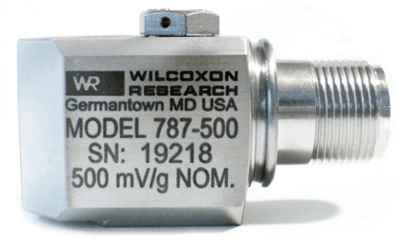Description
Wilcoxon’s side-exit, high-sensitivity broadband accelerometer offers an interior sensing element capable of producing 500 mV/g. This results in clear signals from low-speed, low-level vibration amplitudes up to its full scale capability of 10 g. The low-end frequency response of the 787-500 makes it ideal for slow-speed applications such as wind turbine generators and cooling towers. A high top-end frequency response offers clear signals for early bearing fault detection, gearbox wear, and other high-speed applications. The 787-500 is supplied with a 2 pin MIL-5015 connector.
Low-frequency measurements for condition monitoring can present some of the biggest challenges for vibration detection. Applications typically include slow-speed agitators, wind turbines, cooling towers, semiconductor lithography, and seismic monitoring. Low-frequency measurements and low levels of acceleration are closely related, making the electronic circuitry critical to obtaining a good measurement. In order to have adequate voltage levels with high signal-to-noise ratio at the acquisition equipment, low-frequency accelerometers must have sensing elements with higher output than general-purpose sensors. The low-end frequency cutoff of the amplifier is designed to offer clear signals down to < 0.1 Hz.
Features- Low-Profile
- High sensitivity
- Clear signals at low vibration levels
- Extended low end frequency response
- Improved signal to noise ratio versus other general-purpose accelerometers
- Hermetically sealed
- Rugged design
- ESD-protected
- Reverse wiring protection
- Manufactured in an approved ISO 9001 facility
Specifications
Specifications
Approvals & Certifications
- CE
Approvals & Certifications
- ISO 9001
Circuit Protection
- ESD Protection
- Reverse Wiring Protection
Electrical Connectors
- Cable (J10 / J9T2A)
- Mating Connector: R6 Typical
- Output Connector: 2-Pin, MIL-C-5015 Style
Enclosure, Body Material
- 316L Stainless Steel
Frequency
- Frequency Response (± 10 %): 0.5 to 5,000 Hz
- Frequency Response (± 3 dB): 0.2 to 10,000 Hz
- Resonance Frequency: 22 kHz
Mounting
- 1/4-28 Captive Hex Head Screw, 0.046" Diameter Safety Wire Hole
Noise
- Electrical Noise, Equivalent G (Broadband: 2.5 Hz to 25 kHz): 250 µg
- Electrical Noise, Equivalent G (Spectral: 10 Hz): 2.5 μg√Hz
- Electrical Noise, Equivalent G (Spectral: 100 to 1,000 Hz): 1.5 µg/√Hz
Non-Linearity
- Amplitude Non-Linearity: 1 %
Output Impedence
- Maximum 100 Ω
Power Requirement
- 18-30 Vdc
- Current Regulating Diode: 2-10 mA
Range
- Acceleration Range, Vdc > 22 V: 10 G Peak
Seal Type
- Hermetic
Sensitivity
- Base Strain Sensitivity, Max.
- Electromagnetic Sensitivity, Equivalent G, Max.
- Sensitivity, ± 5 %, 25° C (77° F): 100 mV/g
- Transverse Sensitivity: Max. 5 % of axial
Shock
- Shock Limit: 5,000 G Peak
Temperature Range
- -50° to 120° C (-58° to 248° F)
Vibration
- Vibration Limit: 500 G Peak
Voltage
- Bias Output Voltage: 12 Vdc
